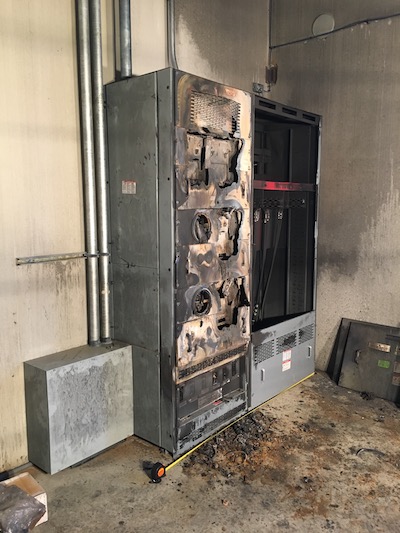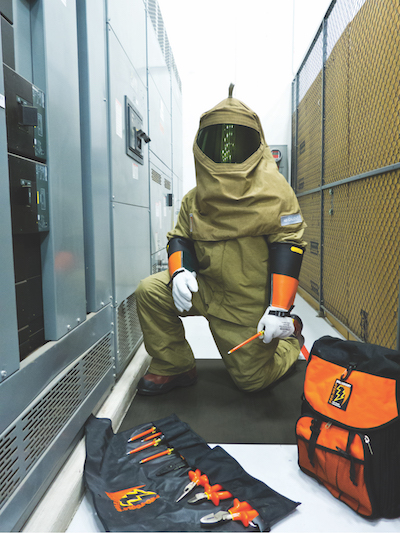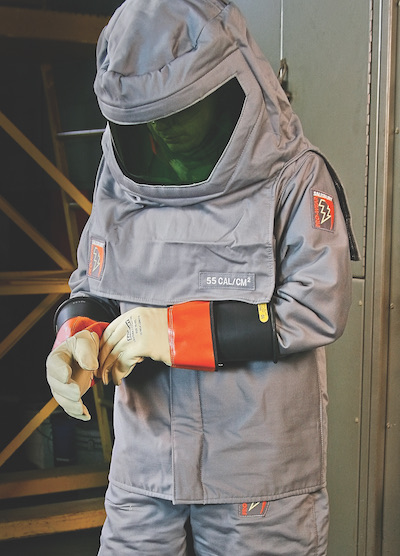Two years ago, the dress code for millions of U.S. workers,
including more than half of the
IBEW’s
members, changed.
For the first time, the Occupational Safety and Health Administration changed parts of its standards covering construction and general industry to make fire resistant and arc-rated clothing personal protective equipment and then required employers to provide it to workers who need it.
The stakes are very high. While most injuries to electrical workers each year are from electrocutions, arc flashes injure five to 10 electricians every day. Every other day, on average, one of them dies.
And the injuries suffered are often catastrophic. Only one-third of arc flash victims are back at work within two months. More than 60 percent, according to a Canadian study, were not back after three months.
Because of advances in materials science, every injury from an arc flash can be prevented if proper precautions are taken and the appropriate gear is worn correctly.
Changes to the standards were designed to put that gear in the hands of every worker exposed to the risk of an arc flash.
“As dangerous as it is to stand inches from a lightning strike, for the first time ever, we have equipment that will protect our members from burns — if they match it to the job and wear it correctly,” said IBEW Safety Director Dave Mullen. “It’s the company’s job to make it available; but in the end, each of us has the ultimate responsibility for our own safety.”
The safety standard change created a gold rush for manufacturers of arc-rated garments. Dozens of new companies entered the market. New brands using new materials suddenly appeared marketing fire resistant and arc-rated gear in hundreds of new styles.
The challenge for IBEW members is that two people wearing what look like identical outfits could have wildly different levels of protection. The difference could be walking away from an arc flash shaken with maybe some red and raw skin and permanent injury or even death.
In this special report from the Electrical Worker, we explain how the market for arc-rated work gear has changed, how to understand the rating systems and how to care for and inspect your gear.
Luck or the Right Gear?
Surviving an Arc Flash
Journeyman wireman Jeremy Sells has done it hundreds of times before. The Portland, Ore., Local 48 member was inside an electrical closet doing maintenance on the 480-volt switchgear for a one-story, mixed-use warehouse and office building in the spring of 2016.

|
| Portland, Ore., Local 48 journeyman wireman Jeremy Sells was kneeling in front of this panel when it arced, repeatedly, melting the front of the switchgear.
|
He and his partner were about to remove one of the six inside covers of the panel to take some heat readings with an infrared camera. It is the standard way to test panels for loose wires and it must be done with the power on.
“There wasn’t anything special about it. Four screws and the cover comes off,” he said. “For working energized, this couldn’t be any safer. I wasn’t even trained that this was hot work.”
They were kneeling side-by-side on the ground. Sells would catch the bolts holding the cover as they came off and would keep the cover pressed over the panel until it was free.
But as soon as the 3/8-inch nut driver turned the first bolt, Sells said, a deafening, split-second hum filled the room.
And then the panel exploded.
“It was just boom after boom after boom,” he said.
Sells’ partner (who prefers to be unnamed) staggered back into the push bar on the door and tumbled out of the room. Sells fell the other way, stumbling back against the wall farthest from the now closed — and locked to the outside — door.
Between him and the door was the panel, and inside it, an arc flash pulsed again and again.
An arc flash is the closure of an electric circuit through the air. Everyone has seen one before. Lightning arcing from the clouds to the ground. The bright blue snap of a static electric shock when reaching out to touch a door knob.
The difference is the power pushing that circuit to close. Air is normally not a very effective conductor of electricity, but if the voltage, current, humidity or dust in the air is high enough, and the distance between the electrode and ground is small enough, air can be forced into the job.
Inside that power closet, the utility transformer unfailingly re-energized the panel, and the panel dutifully arced.
Arcs reach 37,000 degrees Fahrenheit, four times hotter than the surface of the sun. Copper and aluminum inside the panel vaporized and cloaked the room with molten shrapnel. The heat of arc flash can cause lethal burns up to 10 feet away.
Sells was less than an arm’s length.
Arc flashes are more than just terribly hot. They are as loud as a top-fuel drag racer leaving the line. They are so bright they can permanently blind. The force of the rapidly expanding, superheated air can collapse lungs, blow doors off hinges and knock linemen off poles and wiremen off ladders.
“It went dark. I couldn’t see where my partner was. It was much louder than anything I could imagine. I backed off to the corner and I pulled the face shield over my neck and chest,” Sells said.
Sells said he kept expecting the panel to trip. But it never did. With each flash, the total energy released increases and so does the likelihood and severity of burns.
“I thought ‘This will stop and I will walk out.’ But it wasn’t clearing,” Sells said. “I thought, ‘I have got to get out of here. This is not a good place to be. I could die.’”
Sells said he tried to time his run to the door between the explosions. He smashed into the door and out. His partner was waiting outside the door, the drill still in his hand. The door had locked behind him and there was nothing he could do while Sells — and the key — were trapped inside.
The worst could have happened inside that room, but it didn’t.
“I think about that,” Sells said. “But I was unscathed.”
Not a scratch. Not a burn. Some ringing in his ears was it. Despite being in a locked concrete closet with a drum beat of explosions, he was back at work the next day.
The exact cause of the failure is not known, but a forensic exam found that Sells and his partner were not at fault and had followed to the letter the safety protocol written by Clint Elliott, safety manager for Sells’ employer, Capitol Electric.
“The screw hadn’t come out a fingernail’s width,” Elliott said. “That equipment is supposed to survive earthquakes, but it would have exploded if you had given it a hard elbow.”
Sells was fortunate, but he wasn’t lucky.
When the panel so spectacularly failed, he was completely protected by arc-flash-rated personal protective equipment. They were both wearing insulated, arc-rated coveralls, balaclava, face shield and hard hat and 1,000-volt rubber insulating gloves and leather protectors.
His face shield, workbag and cover alls were smoked black and pockmarked by hundreds of pieces of molten copper. He found bb-sized pieces melted into the glass screen of his phone and penny and nickel-sized slugs inside his bag.
One of the coin-sized pieces hit his partner in the neck and stuck to the balaclava. But the next day, all he needed was a Band-Aid. That was the worst injury either suffered.
“It was amazing to see the PPE work. I’m not saying I thought it was just for show, but it’s different to be involved in an explosion yourself and actually see it,” Sells said. “It gives some credibility to the idea that anything can happen, even on something I don’t think is a dangerous task. So dress for the risk.”
PPE: What to Wear and How to Wear It

|
| Arc-rated clothing, matched to the potential risk and worn correctly, saves lives and can prevent nearly every injury.
|
When working energized, every job has risks, but the risks vary. What voltage and amperage? How far away will the electrical worker be? Will covers be on or off? The National Electrical Contractors Association’s handbook explaining what to wear for different tasks, for example, is 35 pages.
Making sure the PPE an electrical worker is given will protect them if everything goes wrong is complicated. To make it even more complicated, while most AR clothes have labels indicating their level of protection, different companies use different labels.
However complicated it may seem, IBEW Safety Director Dave Mullen said, it is worth taking the time to understand what the tags mean, how to match the gear to the risk and how to make sure the gear is on correctly and up to the job.
But the most important step anyone can take is even simpler.
Mullen and Palmer Hickman, director of safety and code training and curriculum development at the Electrical Training Alliance, agree that 80 percent of arc flash-related injuries could be solved if people took a single step: don’t wear fuel.
Don’t Wear Fuel.
The first rule of safe electrical work is to do everything possible to remove the risk by, for example, de-energizing the system. But when exposure is impossible to avoid, the most important rule is get out of fuel disguised as clothing and get into arc-rated garments.
“That’s the life and death difference,” said Scott Margolin, technical vice president for Tyndale, a U.S. manufacturer and distributor of FR and AR work clothes. “Flammable clothing can dramatically increase both the total body surface area affected and how long it is exposed.”
Arc flashes are intensely hot, but most often brief. Clothing fires burn cooler, but longer, and still hot enough to cause second-degree burns within seconds. Burning clothes also spread the flames to the entire body, including parts unexposed to the direct heat and light of an arc flash.
“Fewer people would die each year if they were working naked,” Margolin said. “It is that stark.”
Fabrics that burn include nearly everything in most people’s closets: untreated cotton, polyester, nylon, silk, rayon and wool.
None of it has a place on a lineman or a wireman working hot.
Even under AR protective gear, flammable underwear has the potential to cause grievous injury. A small hole in the outer layer can allow enough heat in to ignite it. A small burn on the skin beneath the hole can become a deadly full-body one, so it is important to properly repair AR clothing.
Those sweat-wicking shirts that make summertime bearable can, and have, burned or melted under the protection of AR coveralls. They are also unnecessary as FR base layers options are out there.
“The first rule is to establish an electrically safe work condition whenever possible,” Hickman said. “Only if that is not possible do we begin talking about PPE, and then nothing is more important than not wearing fuel.”
The larger point, Mullen said, is that the PPE is the last step in keeping a worker safe.
“Working hot is sometimes unavoidable, but, can you stay far enough away that, if it does arc, you aren’t exposed to dangerous energy levels?” Mullen said. “If that isn’t possible, can you substitute the procedure with a safer one? If that isn’t possible, is there an engineering or administrative change that will make the work safer? All of those questions should be asked by the safety director before we begin a conversation about the appropriate PPE.”
Understanding the Label

|
| Every job doesn’t require this level of protection, but no matter the potential power, electrical workers with a risk of exposure to arc flashes should remove flammable and meltable fabrics.
|
Once a worker has removed the fuel hiding as clothes, they should look at the tags on their PPE.
Some say 8-cal, 8-calorie, ATPV 8 Cal or 8-calorie per cm^2 and others might say only Cat. 2 or HRC-2. Some tags will say one number, or a number and a category.
All the numbers are measures of how protective the garments are from the energy of arc flashes. They just express it differently.
The numbers are, basically, like the insulation rating on sleeping bags. A sleeping bag rated to -10 degrees is more insulating than one rated only to 30 degrees. Likewise, on AR gear, the higher the number, either calorie or category, the more energy will be absorbed by the gear before it reaches the wearer.
Arc rating is a measure of the amount of arc energy the fabric can block before the wearer is burned through it. It can be expressed as either arc thermal performance value or energy breakopen threshold based on performance in a standard test.
“If the fabric allows a burn, it gets an ATPV. If it gets a small crack, it gets an EBT,” Margolin said. “In both cases, the wearer is protected from second degree burns below the arc rating of the garment.”
Every garment gets an individual rating, from a simple FR T-shirt and pants rated at 4 cal/cm^2 to a layered and hooded suit that looks like the head-to-toe armor worn by bomb disposal technicians that can earn ratings above 100 cal/cm^2.
Margolin said that no one should simply add two arc ratings to determine the protection of a layered system, by, for example, adding an 8 cal coverall over an 8 cal shirt and figuring it is 16 cals of protection. The two layers must be tested together.
Using the categories instead of individual test results can help workers stay safe by roughly estimating size of the risk when working on things that hadn’t been fully analyzed and rated.
“The good news is the math has been done for you with the tables. The bad news is the math has been done for you,” Margolin said. “Every situation is different. The standard stays the same. You have to make sure it applies to your situation.”
Wearing It Right
Now that the gear is in the workers’ hands, they should know its limitations and how to wear it correctly.
“Follow the requirements to the letter. Wear everything prescribed. This is no place for guesswork or winging it,” Mullen said. “You would not believe how many accident reports I read that say, ‘Was wearing all PPE but forgot to put gloves back on after lunch.’ They weren’t complying with their safety protocol.”
Once everything is in place, there is a right and a wrong way to wear it. Sleeves are down, buttons closed, zippers sealed and shirts tucked in. AR clothes work best when they aren’t tight fitting with at least a layer of air sandwiched between the fabric and the body.
Nothing flammable or meltable can be worn over AR clothes. They should be worn over everything else to work.
Any base layer needs to be AR or at the very least natural and non-melting.
Any damage to the garment must be pointed out to the safety manager and either correctly repaired or disposed of. In any case, don’t wear anything that is frayed or has holes in it.
AR or FR clothes that are oily or dirty must be cleaned before use.
Never wash them in chlorine or nonchlorine bleach, starch, fabric softener, bar soap or dryer sheets. Turn them inside out, wash them separately with liquid detergents on the highest setting allowed, usually warm. If they are especially dirty, most AR clothes can be safely dry cleaned.
The larger point, Mullen said, is no electrical worker, whether a lineman, a factory worker, a wireman or anyone else should mistake the safety standards or a tag on the clothes for actual safety.
“At a minimum, we need to wear clothes that comply with the standards, but there is a lot more to do,” he said. “The standard is not a guarantee. Make sure the PPE is high quality, from a reputable company and then wear and care for it correctly. Every individual has to take responsibility for their own safety and this could save your life.”
Helpful Links
OSHA Revised Rules Section 1910.269
OSHA Revised Rules Section 1926
National Fire Protection Association Standard 70E
Arc Rating Test Standard: ASTM F1959
What is an Arc Flash?
High-Speed Video of a 20kA/ 100A arc with Disconnect in 15 Cycles
Slow Motion Arc Flash
Arc Flash Dangers
How to Protect Yourself